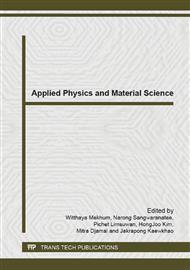p.192
p.196
p.200
p.204
p.208
p.212
p.216
p.220
p.224
Influence of Calcination Temperature on Synthesis of Magnetite (Fe3O4) Nanoparticles by Sol-Gel Method
Abstract:
Magnetite (Fe3O4) nanoparticles were successfully synthesized by the sol-gel method from ferric nitrate-EG (EG=ethylene glycol) gel. The precursors were calcined in argon under an atmospheric pressure at the temperatures varied from 400°C to 500°C. The synthesized magnetic nanoparticles were characterized by X-ray diffractrometer (XRD), field emission scanning electron microscope (FE-SEM) and vibrating sample magnetometer (VSM). The XRD patterns of powder calcined temperature at 400๐C showed clearer Fe3O4 phase than those calcined at other temperatures. The particle size and morphology of magnetic nanoparticles were studied using FE-SEM. The FE-SEM images showed that the particle sizes varied from 30-108 nm. The particle sizes increased with the increase of calcination temperature. VSM measurements indicated that the Fe3O4 nanoparticles were soft ferrite with the maximum magnetization (Mm) and coercivity (Hc) of 35 emu/g and 17 Oe, respectively.
Info:
Periodical:
Pages:
208-211
Citation:
Online since:
June 2014
Authors:
Keywords:
Price:
Сopyright:
© 2014 Trans Tech Publications Ltd. All Rights Reserved
Share:
Citation:


